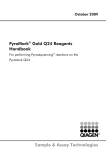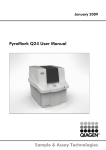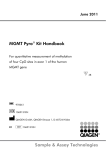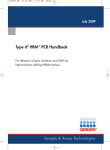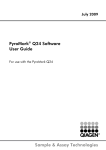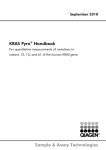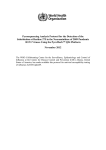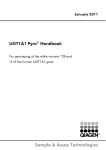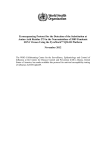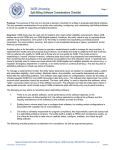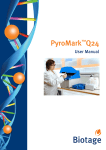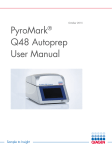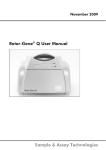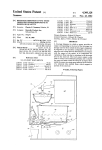Download Sample & Assay Technologies PyroMark® Q24 Validation
Transcript
September 2009 PyroMark® Q24 Validation Oligo Handbook For performance check of the PyroMark Q24 system Sample & Assay Technologies QIAGEN Sample and Assay Technologies QIAGEN is the leading provider of innovative sample and assay technologies, enabling the isolation and detection of contents of any biological sample. Our advanced, high-quality products and services ensure success from sample to result. QIAGEN sets standards in: Purification of DNA, RNA, and proteins Nucleic acid and protein assays microRNA research and RNAi Automation of sample and assay technologies Our mission is to enable you to achieve outstanding success and breakthroughs. For more information, visit www.qiagen.com. Contents Kit Contents 4 Storage 4 Product Use Limitations 4 Product Warranty and Satisfaction Guarantee 4 Technical Assistance 5 Quality Control 5 Safety Information 5 Introduction 7 Principle and procedure 7 Description of protocols 8 Equipment and Reagents to Be Supplied by User 9 Protocols Setting Up a PyroMark Q24 Validation Oligo Assay 10 Run Setup for Performance Test of the PyroMark Q24 System 11 Preparation of PyroMark Q24 Validation Oligo Mixes and Dilution Series 13 Determination of Linearity, Bias, and Repeatability 16 Analysis of Linearity 22 Analysis of Bias and Repeatability 26 Troubleshooting Guide 28 Appendix A: Preparing the PyroMark Q24 Vacuum Workstation 31 Appendix B: Emptying the Waste Container and Troughs 32 References 33 Ordering Information 34 PyroMark Q24 Validation Oligo Handbook 09/2009 3 Kit Contents PyroMark Q24 Validation Oligo Catalog no. 979204 Number of assays 3 PyroMark Q24 Validation Oligo 5% (20 μM) 70 μl PyroMark Q24 Validation Oligo 95% (20 μM) 70 μl Dilution Buffer 2 x 1.7 ml Handbook 1 Storage The PyroMark Q24 Validation Oligo should be stored at –20°C upon arrival. Repeated thawing and freezing (>4 x) should be avoided. The PyroMark Q24 Validation Oligo is stable until the expiration date when stored under these conditions. Product Use Limitations The PyroMark Q24 Validation Oligo is intended for molecular biology applications. This product is neither intended for the diagnosis, prevention, or treatment of a disease, nor has it been validated for such use either alone or in combination with other products. Therefore, the performance characteristics of the products for clinical use (i.e., diagnostic, prognostic, therapeutic, or blood banking) are unknown. All due care and attention should be exercised in the handling of the products. We recommend all users of QIAGEN products to adhere to the NIH guidelines that have been developed for recombinant DNA experiments, or to other applicable guidelines. Product Warranty and Satisfaction Guarantee QIAGEN guarantees the performance of all products in the manner described in our product literature. The purchaser must determine the suitability of the product for its particular use. Should any product fail to perform satisfactorily due to any reason other than misuse, QIAGEN will replace it free of charge or refund the purchase price. We reserve the right to change, alter, or modify any product to enhance its performance and design. If a QIAGEN product does not meet your expectations, simply call your local Technical Service Department or distributor. We will credit your account or exchange the product — as you wish. 4 PyroMark Q24 Validation Oligo Handbook 09/2009 Separate conditions apply to QIAGEN scientific instruments, service products, and to products shipped on dry ice. Please inquire for more information. A copy of QIAGEN terms and conditions can be obtained on request, and is also provided on the back of our invoices. If you have questions about product specifications or performance, please call QIAGEN Technical Services or your local distributor (see back cover or visit www.qiagen.com). Technical Assistance At QIAGEN, we pride ourselves on the quality and availability of our technical support. Our Technical Service Departments are staffed by experienced scientists with extensive practical and theoretical expertise in sample and assay technologies and the use of QIAGEN products. If you have any questions or experience any difficulties regarding PyroMark Q24 Validation Oligo or QIAGEN products in general, please do not hesitate to contact us. QIAGEN customers are a major source of information regarding advanced or specialized uses of our products. This information is helpful to other scientists as well as to the researchers at QIAGEN. We therefore encourage you to contact us if you have any suggestions about product performance or new applications and techniques. For technical assistance and more information, please see our Technical Support Center at www.qiagen.com/Support or call one of the QIAGEN Technical Service Departments or local distributors (see back cover or visit www.qiagen.com). Quality Control In accordance with QIAGEN’s ISO-certified Quality Management System, each lot of PyroMark Q24 Validation Oligo is tested against predetermined specifications to ensure consistent product quality. Safety Information When working with chemicals, always wear a suitable lab coat, disposable gloves, and protective goggles. For more information, please consult the appropriate material safety data sheets (MSDSs). These are available online in convenient and compact PDF format at www.qiagen.com/support/MSDS.aspx where you can find, view, and print the MSDS for each QIAGEN kit and kit component. PyroMark Q24 Validation Oligo Handbook 09/2009 5 24-hour emergency information Emergency medical information in English, French, and German can be obtained 24 hours a day from: Poison Information Center Mainz, Germany Tel: +49-6131-19240 6 PyroMark Q24 Validation Oligo Handbook 09/2009 Introduction The PyroMark Q24 Validation Oligo provides a means to check the performance of the PyroMark Q24 system. Principle and procedure The product consists of 2 biotinylated oligonucleotides that differ in sequence in one position, synthesized as A or G. A variable position is generated by mixing the 2 oligonucleotides in different proportions. C or T is incorporated upon sequencing and the variable position is analyzed as %C. Replicates of the mixes are used to determine linearity, bias, and repeatability. These determinations constitute the performance test of the system.* The limits of the proportions of the 2 mixes, 5% and 95%, have been carefully chosen to coincide with the generally-accepted limits for reliable quantification as determined by in-house evaluation and published data (2–8). The performance test is valid for the whole PyroMark Q24 system since the mixes are prepared through PyroMark Q24 Vacuum Workstation before analysis in the PyroMark Q24 instrument. Both oligonucleotides can form an internal stem–loop structure. This structure enables self-priming of the oligonucleotides for extension by the DNA polymerase and eliminates the need for a sequencing primer in the Pyrosequencing reaction. Figure 1 shows the structure of the oligonucleotides. A B Figure1. Structure of the PyroMark Q24 Validation Oligos. A The open structure of the oligonucleotides. B The self-primed structure of the oligonucleotides, with the analyzed sequence indicated. * The terminology for performance parameters are definitions adapted from reference 1 (see “References”, page 33). Linearity: Ability, within a given measuring interval, to provide measurement results that are directly proportional to the value of %C in the sample. Bias: Difference between the results of measurement and a true value of %C. Reproducibility: Precision of successive measurement results for %C carried out under essentially unchanged conditions of measurement (for example, replicates). PyroMark Q24 Validation Oligo Handbook 09/2009 7 Description of protocols The workflow below illustrates the assay procedure. Workflow of PyroMark Q24 Validation Oligo procedure Assay and Run Setup Sample preparation Assay Setup (Protocol 1) Dilution of each PyroMark Q24 Validation Oligo (Protocol 3) v Preparation of mixes with different %C (Protocol 3) v v Run Setup (Protocol 2) Dilution of mixes to 0.1 μM and 0.025 μM (Protocol 3) v Preparation of samples (Protocol 4) v v Immobilization (Protocol 4) PyroMark Q24 run (Protocol 4) v Analysis of PyroMark Q24 run for linearity (Protocol 5) v Analysis of PyroMark Q24 run for bias and repeatability (Protocol 6) v Report 8 PyroMark Q24 Validation Oligo Handbook 09/2009 Equipment and Reagents to Be Supplied by User When working with chemicals, always wear a suitable lab coat, disposable gloves, and protective goggles. For more information, consult the appropriate material safety data sheets (MSDSs), available from the product supplier. For use on the PyroMark Q24 PyroMark Q24 (cat. no. 9001514)* PyroMark Q24 Software (cat. no. 9019062) PyroMark Q24 Plate (cat. no. 979201) PyroMark Q24 Cartridge (cat. no. 979202) PyroMark Q24 Vacuum Workstation (cat. no. 9001518 [220V]; 9001516 [110V]; 9001519 [100V])* PyroMark Gold Q24 Reagents (cat. no. 970802) PyroMark Binding Buffer (cat. no. 979006) PyroMark Denaturation Solution (cat. no. 979007) PyroMark Wash Buffer, concentrate (cat. no. 979008) PyroMark Annealing Buffer (cat. no. 979009) Streptavidin Sepharose® High Performance (GE Healthcare, cat. no. 175113-01; www.gelifesciences.com) Plate mixer* for immobilization to beads Heating block* capable of attaining 80°C 24-well PCR plate or strips Strip caps 1.5 ml or 2 ml microcentrifuge tubes for dilution of the PyroMark Q24 Validation Oligo Permanent pen for labeling tubes High-purity water (Milli-Q® 18.2 MΩ x cm or equivalent) Ethanol (70%) Pipets (adjustable)* Sterile pipet tips * Ensure that instruments have been checked and calibrated according to the manufacturer’s recommendations. PyroMark Q24 Validation Oligo Handbook 09/2009 9 Protocol 1: Setting Up a PyroMark Q24 Validation Oligo Assay Important point before starting For further information on how to create an Assay Setup and a Run Setup, see the PyroMark Q24 Software User Guide. The Assay can be set up using either AQ or CpG mode. Procedure 1. Set up an assay for the PyroMark Q24 Validation Oligo by using the PyroMark Q24 Software. 2. Click in the toolbar and select “New AQ Assay” or “New CpG Assay”). 3. Type the following sequence in “Sequence to Analyze”. TAYGGTTTGA For more information on how to create an Assay Setup file, see the PyroMark Q24 Software User Guide. 4. Click the “Generate Dispensation Order” icon to get the following nucleotide dispensation order: AQ: CTGACTGTG CpG: ATGATCGTG 3 2 1 0 C T G A C T G T G 5 Figure 2. Histogram for AQ mode. The first and third nucleotide additions are blank dispensations and serve as negative controls. The fifth and sixth dispensations constitute the variable position created by the mixing of the 2 oligonucleotides. 5. Click 10 in the toolbar to save the assay. PyroMark Q24 Validation Oligo Handbook 09/2009 Protocol 2: Run Setup for Performance Test of the PyroMark Q24 System Important points before starting For instructions on how to create a new Run Setup, see the PyroMark Q24 Software User Guide. It is recommended to set up the samples in a random pattern in the PyroMark Q24 Plate. An example of a random pattern is given in Table 1 and Table 2, where the letters refer to the mixes in Table 3 (see “Protocol 3: Preparation of PyroMark Q24 Validation Oligo Mixes and Dilution Series”). Enter %C as Sample ID. Two Run Setups have to be prepared for each test: one for 0.5 picomoles and one for 2 picomoles. Procedure 1. Create 2 Run Setups for linearity determination by importing the Assay Setup assay parameters to the appropriate number of plates and wells as shown in Table 1. Save the Run Setups as “Linearity_0.5picomol” and “Linearity_2picomol”. To add an assay to a well, you can either: Right-click the well and select “Load Assay” from the context menu Select the assay in the shortcut browser, and click and drag the assay to the well. A well is color-coded according to the assay type loaded onto the well. For more information on how to create a Run Setup file, see the PyroMark Q24 Software User Guide. Table 1. Plate setup for linearity determination 1 2 3 4 5 6 7 8 A A C – F B E – G B D G C D F B C D C A F E A B E – G PyroMark Q24 Validation Oligo Handbook 09/2009 11 2. Create 2 Run Setups for bias and repeatability determination by importing the Assay Setup parameters to the appropriate number of plates and wells as shown in Table 2. Save the Run Setups as “BiasRepeatability_0.5picomol” and “BiasRepeatability_2picomol”. Table 2. Plate setup for bias and repeatability determination 1 2 3 4 5 6 7 8 A C A B B C C A B B A C A B B C A B C C A B A C B C A 3. Save the Run Setups to a USB memory stick (supplied with the PyroMark Q24 System). 4. Print a list of required volumes of enzyme mix, substrate mix, and nucleotides, and the plate setup for each Run Setup. Select “Pre Run Information” from the “Tools” menu and, when the report appears, click . 12 PyroMark Q24 Validation Oligo Handbook 09/2009 Protocol 3: Preparation of PyroMark Q24 Validation Oligo Mixes and Dilution Series Important points before starting Accurate pipetting is critical to obtain the correct mixtures. The method described below involves successive mixing of equal volumes of solutions. This reduces errors in pipetting. It is still critical that the same pipetting technique is used for all mixes, to ensure that equal volumes are indeed dispensed. The dilution buffer supplied with the PyroMark Q24 Validation Oligo contains an agent that effectively eliminates adsorption of the oligonucleotides to plastic surfaces that might adversely affect performance. It is important that this buffer is used where specified. The PyroMark Q24 Validation Oligo is itself stored in this buffer. Procedure 1. The dilution buffer provided with the PyroMark Q24 Validation Oligo needs to be diluted before use. Prepare 1x dilution buffer by mixing 600 μl of 10x dilution buffer with 5400 μl of high-purity water. Note: The agent may cause bubble formation during pipetting. 2. Prepare 1.5 ml or 2 ml microcentrifuge tubes for the dilution series. Label the tubes as follows: A1, B1, C1, D1, E1, F1, G1 A0.1, B0.1, C0.1, D0.1, E0.1, F0.1, G0.1 A0.025, B0.025, C0.025, D0.025, E0.025, F0.025, G0.025 3. Pipet 30 μl of the PyroMark Q24 Validation Oligo 5% (20 μM) into the tube marked “A1”. 4. Pipet 30 μl of the PyroMark Q24 Validation Oligo 95% (20 μM) into the tube marked “B1”. 5. Add 570 μl each of dilution buffer 1x (from step 1) to tubes “A1” and “B1” to generate 1 μM solutions of each PyroMark Q24 Validation Oligo. Mix by pipetting up and down. To ensure comparable dilutions, we strongly recommend to pipet the 30 μl aliquots and 570 μl without changing any settings on the pipet between mixes. PyroMark Q24 Validation Oligo Handbook 09/2009 13 6. Prepare solutions for tubes “C1” through “G1” as shown in Table 3. Table 3. Preparation of PyroMark Q24 Validation Oligo mixes with different %C contents Tube label Mix together Final volume %C A1 – – 600 μl 5% B1 – – 600 μl 95% C1 200 μl A1 200 μl B1 400 μl 50% D1 100 μl A1 100 μl C1 200 μl 27.5% E1 100 μl A1 100 μl D1 200 μl 16.3% F1 100 μl B1 100 μl C1 200 μl 72.5% G1 100 μl B1 100 μl F1 200 μl 83.8% 7. Prepare solutions for tubes “A0.1” through “G0.1” by diluting each solution “A1” through “G1” to 0.1 μM as shown in Table 4. Table 4. Dilution of the PyroMark Q24 Validation Oligo mixes for tubes “A0.1” through “G0.1” Component Volume Concentration Solutions “A1” through “G1” (from step 6) 30 μl 1 μM 1x Dilution buffer * 270 μl – Solutions “A0.1” through “G0.1” 300 μl 0.1 μM * Make sure that the 10x dilution buffer supplied with the PyroMark Q24 Validation Oligo is diluted with high-purity water before use. See step 1. 8. Prepare solutions for tubes “A0.025” through “G0.025” by performing a second dilution of each solution “A0.1” through “G0.1” to 0.025 μM as shown in Table 5. 14 PyroMark Q24 Validation Oligo Handbook 09/2009 Table 5. Dilution of the PyroMark Q24 Validation Oligo mixes for tubes “A0.025” through “G0.025” Component Volume Concentration Solutions “A0.1” through “G0.1” (from step 7) 60 μl 0.1 μM 1x Dilution buffer * 180 μl – Solutions “A0.025” through “G0.025” 240 μl 0.025 μM * Make sure that the 10x dilution buffer supplied with the PyroMark Q24 Validation Oligo is diluted with high-purity water before use. See step 1. The remaining volumes of PyroMark Q24 Validation Oligos in tubes “A1” through “G1” can be stored at –20°C for up to 1 month. Repeated thawing and freezing (>4 x) should be avoided. PyroMark Q24 Validation Oligo Handbook 09/2009 15 Protocol 4: Determination of Linearity, Bias, and Repeatability Things to do before starting Follow the instructions in PyroMark Q24 User Manual to install the PyroMark Q24. Place the PyroMark Q24 Plate Holder on a heating block at 80°C for use in step 26. Allow all required reagents and solutions to reach room temperature (15–25°C) before starting. Label 4 PyroMark Q24 Plates as follows: Plate 1, Plate 2, Plate 3, Plate 4 Procedure 1. Gently shake the bottle containing Streptavidin Sepharose High Performance until it is a homogeneous solution. 2. Prepare a master mix for DNA immobilization according to Table 6. Prepare a volume at least 10% greater than that required for the total number of reactions to be performed. This protocol calls for 4 x 24 = 96 reactions. Table 6. Master mix for DNA immobilization Number of samples 1 110* Streptavidin Sepharose High Performance 2 μl 220 μl PyroMark Binding Buffer 40 μl 4.4 ml High-purity water 18 μl 1.98 ml Total volume 60 μl 6.60 ml * Provides a sufficient amount for the 4 x 24 = 96 samples required. 3. Add 60 μl of the master mix to all 24 wells of four 24-well PCR plates. Label the plates as follows. Plate 1, Plate 2, Plate 3, Plate 4 4. Plate 1: Pipet 20 μl of each PyroMark Q24 Validation Oligo mix 0.025 μM (tubes “A0.025” through “G0.025” from “Protocol 3: Preparation of PyroMark Q24 Validation Oligo Mixes and Dilution 16 PyroMark Q24 Validation Oligo Handbook 09/2009 Series”) in triplicates to “Plate 1” in the same pattern as in the Run Setup for “Linearity_0.5picomol” (see the Pre Run Information report from “Protocol 2: Run Setup for Performance Test of the PyroMark Q24 System”). The 3 wells that remain can be used as negative controls. Add 20 μl 1x dilution buffer instead of oligonucleotides. The total volume per well should be 80 μl after addition of the PyroMark Q24 Validation Oligo mixes. 5. Plate 2: Pipet 20 μl of each PyroMark Q24 Validation Oligo mix 0.1 μM (tubes “A0.1” through “G0.1” from “Protocol 3: Preparation of PyroMark Q24 Validation Oligo Mixes and Dilution Series”) in triplicates to “Plate 2” in the same pattern as in the Run Setup for “Linearity_2picomol” (see the Pre Run Information report from “Protocol 2: Run Setup for Performance Test of the PyroMark Q24 System”). The 3 wells that remain can be used as negative controls. Add 20 μl 1x dilution buffer instead of oligonucleotides. The total volume per well should be 80 μl after addition of the PyroMark Q24 Validation Oligo mixes. 6. Plate 3: Pipet 20 μl of the first 3 PyroMark Q24 Validation Oligo mixes 0.025 μM (tubes “A0.025” through “C0.025” from “Protocol 3: Preparation of PyroMark Q24 Validation Oligo Mixes and Dilution Series”) in replicates of eight to “Plate 3” in the same pattern as in the Run Setup for “BiasRepeatability_0.5picomol” (see the Pre Run Information report from “Protocol 2: Run Setup for Performance Test of the PyroMark Q24 System”). The total volume per well should be 80 μl after addition of the PyroMark Q24 Validation Oligo mixes. 7. Plate 4: Pipet 20 μl of the first 3 PyroMark Q24 Validation Oligo mixes 0.1 μM (tubes “A0.1” through “C0.1” from “Protocol 3: Preparation of PyroMark Q24 Validation Oligo Mixes and Dilution Series”) in replicates of eight to “Plate 4” in the same pattern as in the Run Setup for “BiasRepeatability_2picomol” (see the Pre Run Information report from “Protocol 2: Run Setup for Performance Test of the PyroMark Q24 System”). The total volume per well should be 80 μl after addition of the PyroMark Q24 Validation Oligo mixes. 8. Seal the PCR plates (“Plate 1” through “Plate 4”) using strip caps. PyroMark Q24 Validation Oligo Handbook 09/2009 17 9. Agitate “Plate 1” at room temperature (15–25°C) for 5 min at 1400 rpm. Sepharose beads sediment quickly. If more than 1 min has elapsed since the plate was agitated, agitate again for 1 min before capturing the beads. During this step, prepare the PyroMark Q24 Vacuum Workstation for sample preparation (see Appendix A, page 31). 10. Add 25 μl of PyroMark Annealing Buffer to each well of PyroMark Q24 Plate 1. Keep one of the PyroMark Q24 Plate Holders (supplied with the PyroMark Q24 Vacuum Workstation) at room temperature (15–25°C), and use it as support when preparing and moving the plates. Since the oligonucleotides are self-primed, no sequencing primer is required. The beads are released into PyroMark Annealing Buffer. 11. Place PCR “Plate 1” and a PyroMark Q24 Plate on the worktable of the PyroMark Q24 Vacuum Workstation (see Figure 3). Ensure that the plate is in the same orientation as when samples were loaded. Figure 3. Placement of PCR plate and PyroMark Q24 Plate on the PyroMark Q24 Vacuum Workstation. The marked positions contain 70% ethanol (1), PyroMark Denaturation Solution (2), PyroMark Wash Buffer (3), and high-purity water (4, 5). P: Parking position. 12. Turn on the pump and apply vacuum to the vacuum tool by opening the vacuum switch. 13. Carefully lower the filter probes into the PCR plate to capture the beads containing immobilized template. Hold the probes in place for 15 s. Take care when picking up the tool. Sepharose beads sediment quickly. If more than 1 min has elapsed since the plate was agitated, agitate again for 1 min before capturing the beads. 14. Transfer the tool to the trough containing 70% ethanol (trough 1). Flush the filter probes for 5 s. 15. Transfer the tool to the trough containing PyroMark Denaturation Solution (trough 2). Flush the filter probes for 5 s. 18 PyroMark Q24 Validation Oligo Handbook 09/2009 16. Transfer the tool to the trough containing PyroMark Wash Buffer (trough 3). Flush the filter probes for 10 s. 17. Raise the tool up and back, beyond 90° vertical, for 5 s to drain liquid from the filter probes (see Figure 4). Figure 4. Illustration of the vacuum tool raised to beyond 90° vertical. 18. While the tool is held over the PyroMark Q24 Plate, close the vacuum switch on the tool (Off). 19. Release the beads in the plate containing 25 μl PyroMark Annealing Buffer by shaking the tool from side to side. Allow the filter probes to rest on the bottom of the wells. 20. With the vacuum switch closed (Off), transfer the tool to the trough containing high-purity water (trough 4) and agitate the tool for 10 s. 21. Wash the filter probes by lowering the probes into high-purity water (trough 5) and applying a vacuum. Flush the filter probes with 70 ml high-purity water. 22. Raise the tool up and back, beyond 90° vertical, for 5 s to drain liquid from the filter probes (see Figure 4). 23. Close the vacuum switch on the tool (Off), and place the tool in the Parking (P) position. 24. Repeat steps 9–23 for the remaining PCR plates (“Plate 2”, “Plate 3”, “Plate 4”). 25. Turn off the vacuum pump. At the end of a working day, liquid waste and remaining solutions should be discarded and the PyroMark Q24 Vacuum Workstation should be checked for dust and spillage, see Appendix B, page 32. 26. Heat the 4 PyroMark Q24 Plates with the samples at 80°C for 2 min using a heating block and the prewarmed PyroMark Q24 Plate Holder. Note: It is possible to process 4 PyroMark Q24 Plates sequentially. 27. Remove the PyroMark Q24 Plates from the plate holder and let the samples cool to room temperature (15–25°C) for at least 5 min. PyroMark Q24 Validation Oligo Handbook 09/2009 19 Note: Since only 1 plate can be processed on the PyroMark Q24 at any given time, keep the other plates on the bench at room temperature. 28. Load a PyroMark Q24 Cartridge with the appropriate volumes of PyroMark Gold Q24 Reagents, as given in the Pre Run Information report for “Linearity_0.5picomol” from “Protocol 2: Run Setup for Performance Test of the PyroMark Q24 System”. The Pre Run Information report, found in the “Tools” menu at run setup (see the PyroMark Q24 Software User Guide), provides information about the volume of nucleotides, enzyme mixture, and substrate mixture needed for the assay. 29. Open the cartridge gate and insert the filled PyroMark Q24 Cartridge with the label facing out. Push the cartridge in fully and then push it down. 30. Ensure the cartridge is properly inserted and close the gate. 31. Open the plate-holding frame and place the PyroMark Q24 Plate (“Plate 1”) on the heating block. 32. Close the plate-holding frame and the instrument lid. 33. Insert the USB memory stick (containing the run file) into the USB port at the front of the instrument. Do not remove the USB stick before the run is finished. 34. Select “Run” in the main menu (using the and screen buttons) and press “OK”. 35. Select the run file “Linearity_0.5picomol” using the and screen buttons. To view the contents of a folder, select the folder and press “Select”. To go back to the previous view, press “Back”. 36. When the run file is selected, press “Select” to start the run. 37. When the run is finished and the instrument confirms that the run file has been saved to the USB memory stick, press “Close”. 38. Open the instrument lid. 39. Open the cartridge gate and remove the PyroMark Q24 Cartridge by lifting it up and pulling it out. 40. Close the gate. 41. Open the plate-holding frame and remove the PyroMark Q24 Plate from the heating block. 42. Close the plate-holding frame and the instrument lid. 43. Clean the PyroMark Q24 Cartridge if you choose not to immediately continue with the next plate (see the PyroMark Gold Q24 Reagents Handbook). 20 PyroMark Q24 Validation Oligo Handbook 09/2009 44. Refill the PyroMark Q24 Cartridge with the appropriate volumes of PyroMark Gold Q24 Reagents, as given in the Pre Run Information report for “Linearity_2picomol” from “Protocol 2: Run Setup for Performance Test of the PyroMark Q24 System”. The Pre Run Information report, found in the “Tools” menu at run setup (see the PyroMark Q24 Software User Guide), provides information about the volume of nucleotides, enzyme mixture, and substrate mixture needed for the assay. 45. Open the cartridge gate and insert the filled PyroMark Q24 Cartridge with the label facing out. Push the cartridge in fully and then push it down. 46. Ensure the cartridge is properly inserted and close the gate. 47. Open the plate-holding frame and place the PyroMark Q24 Plate (“Plate 2”) on the heating block. 48. Close the plate-holding frame and the instrument lid. 49. Insert the USB memory stick (containing the run file) into the USB port at the front of the instrument. Do not remove the USB stick before the run is finished. 50. Select “Run” in the main menu (using the and screen buttons) and press “OK”. 51. Select the run file “Linearity_2picomol” using the and screen buttons. To view the contents of a folder, select the folder and press “Select”. To go back to the previous view, press “Back”. 52. When the run file is selected, press “Select” to start the run. 53. When the run is finished and the instrument confirms that the run file has been saved to the USB memory stick, press “Close”. 54. Repeat steps 38–53 for the remaining PyroMark Q24 Plates (“Plate 3”, “Plate 4”). For “Plate 3”, use the Run file saved as “BiasRepeatability_0.5picomol”. For “Plate 4”, use the Run file saved as “BiasRepeatability_2picomol”. 55. Remove the USB memory stick. 56. Discard the PyroMark Q24 Plates and clean the PyroMark Q24 Cartridge (see the PyroMark Gold Q24 Reagents Handbook). PyroMark Q24 Validation Oligo Handbook 09/2009 21 Protocol 5: Analysis of Linearity The linearity of the assay can be tested at 2 levels: according to the Clinical Laboratory Standards Institute Guideline EP6-A9, as recommended by the Standard EN-13612 10, and using validated software, or by simple linear regression analysis. Claimed performance for both CpG and AQ modes according to EP6-A For 0.5–2 picomoles of the PyroMark Q24 Validation Oligo using the method described here, the method has been demonstrated to be linear from 5% to 95% C within an allowed nonlinearity of 3 percentage units in this interval. Linearity according to CLSI EP6-A This method involves fitting linear and polynomial equations to the data. The method then determines if the fit of the polynomial equation is significantly better than that of the linear equation, in which case the data is nonlinear. However, acceptance limits may be set for nonlinearity to match the practical needs of the assay. These are included in the analysis of the data to determine if any nonlinearity that is detected is acceptable. There are a number of software products on the market to analyze data according to EP6-A10. The Software can be validated using, for example, datasets from the National Institute of Standards and Technology, USA (www.nist.gov). Procedure 1. Open the run files for “Linearity_0.5picomol” and “Linearity_2picomol” in the PyroMark Q24 Software and analyze all wells. All wells expect the negative controls should be given “Passed” quality, shown as a blue bar in the lower field of the well and with %C indicated in a blue rectangle in the Pyrogram® output. Figure 5. Example of AQ assay result from a 50% mix (tube “C0.1”). 22 PyroMark Q24 Validation Oligo Handbook 09/2009 2. Determine the single peak heights. Ideally the peaks should be between 30 ± 10 RLU for samples with 0.5 picomoles of template and above 120 ± 40 RLU for samples with 2 picomoles of template. To obtain peak height values, select “Export Peak Heights” from the “Tools” menu. Save the data in a suitable format (*.csv or *.tsv). Open this file in Microsoft® Excel (Delimited), and calculate the mean single peak height and background for each well as described below. 3. Select the “AQ/CpG Analysis Results” from the “Reports” menu to open the analysis result report. 4. Save the data in a suitable format (*.csv or *.tsv). 5. Open the data file in the Software. 6. Prepare a table with expected and actual values. An example is shown in Table 7 on page 24. 7. Analyze the linearity according to the software instructions. An example of linearity analysis is shown in Figure 6 on page 25. PyroMark Q24 Validation Oligo Handbook 09/2009 23 Table 7. Expected and actual %C values Tube label A E D C F G B Sample Expected %C Actual %C* 1 5 6.22 2 5 6.17 3 5 5.06 1 16.3 18.20 2 16.3 17.90 3 16.3 18.12 1 27.5 31.2 2 27.5 29.89 3 27.5 29.89 1 50 51.88 2 50 52.62 3 50 52.27 1 72.5 74.76 2 72.5 74.66 3 72.5 75.31 1 83.8 85.28 2 83.8 85.53 3 83.8 85.68 1 95 95.30 2 95 95.40 3 95 95.73 * These values are given as an example only. Actual values must be determined. 24 PyroMark Q24 Validation Oligo Handbook 09/2009 A Linearity Plot 100 90 80 70 Linear fit (1.905 +0.9967x) Actual 60 Polynomial fit (0.4493 +1.097x -0.001002x²) 50 40 30 20 10 0 0 20 40 60 80 100 Expected B Difference Plot Allow able non-linearity (3) 4 Difference (Non-linear fit - Linear fit) 3 2 1 0 -1 -2 -3 -4 0 20 40 60 80 100 Concentration Figure 6. Example of linearity analysis. A The linear fit and the polynomial fit are shown graphically. The polynomial fit is statistically significant. B The difference plot shows that the data is well within the limits of allowed nonlinearity of 3 percentage units. PyroMark Q24 Validation Oligo Handbook 09/2009 25 Protocol 6: Analysis of Bias and Repeatability Claimed performance for both CpG and AQ modes For 0.5–2 picomoles of the PyroMark Q24 Validation Oligo using the method described here, the method has been demonstrated to give the following performance: Repeatability, measured as standard deviation for 8 replicates, better than 3 percentage units in the range 5% C to 95% C Bias less than 5 percentage units for a mean of 8 replicates in the range 5% C to 95% C. The mixes “A”, “B”, and “C”, with 5% C, 95% C, and 50% C, respectively, are used to determine repeatability, bias, and intermediate precision. Procedure 1. Open the run files for “BiasRepeatability_0.5picomol” and “BiasRepeatability_2picomol” in the PyroMark Q24 Software and analyze all wells. All wells should be given “Passed” quality, shown as a blue bar in the lower field of the well and with %C indicated in a blue rectangle in the Pyrogram output. Figure 7. Example of AQ assay result from a 50% mix (tube “C0.1”). 2. Determine the single peak heights. Ideally the peaks should be between 30 ± 10 RLU for samples with 0.5 picomoles of template and above 120 ± 40 RLU for samples with 2 picomoles of template. To obtain peak height values, select “Export Peak Heights” from the “Tools” menu. Save the data in a suitable format (*.csv or *.tsv). Open this file in Microsoft Excel (Delimited), and calculate the mean single peak height and background for each well as described below. 26 PyroMark Q24 Validation Oligo Handbook 09/2009 3. Select the “AQ/CpG Analysis Results” from the “Reports” menu to open the analysis result report. 4. Save the data in a suitable format (*.csv or *.tsv). 5. Open the data file in the software. 6. Prepare a table with expected and actual values. An example is shown in Table 7 on page 24. 7. The data obtained from the analysis should be analyzed by validated statistical software. The mean and standard deviation for each mix is calculated, based on the 8 replicates. An example of data can be found in Table 8. Table 8. Results of bias and reproducibility determination Performance Expected %C Actual %C* Standard deviation* Bias* 5 5.2 0.2 0.2 50 52.7 0.7 2.7 95 95.2 0.5 0.2 * These values are given as an example only. Actual values must be determined. 8. Test for intermediate precision. Intermediate precision can be tested using the same mixes in combination with the desired level of variation in terms of operator, instrument, and other reagents. PyroMark Q24 Validation Oligo Handbook 09/2009 27 Troubleshooting Guide This troubleshooting guide may be helpful in solving any problems that may arise. For more information, see also the Frequently Asked Questions page at our Technical Support Center: www.qiagen.com/FAQ/FAQList.aspx. The scientists in QIAGEN Technical Services are always happy to answer any questions you may have about either the information or protocols in this handbook or sample and assay technologies (for contact information, see back cover or visit www.qiagen.com). Refer to the PyroMark Q24 User Manual for general troubleshooting of the instrument. Comments and suggestions Poor or incorrect sequence a) PyroMark Q24 Validation Follow the instruction in the protocols for Oligo not correctly preparing the PyroMark Q24 Validation Oligo. prepared Make sure to dilute the PyroMark Q24 Validation Oligo in the dilution buffer as described in the protocols. Make sure that the 10x dilution buffer provided is first diluted to 1x using high-purity water. b) Incorrect sequence to analyze or dispensation order Check that the correct sequence was typed in the Assay Setup. c) Buffers or reagents incorrectly diluted or incorrectly stored Follow the instructions supplied with the reagents. Include an empty well (containing only PyroMark Annealing Buffer) in your run to check if background peaks are coming from the nucleotides. d) Dispensation error (seen, for example, as split peaks) Clean or replace the PyroMark Q24 Cartridge. If the problem remains, contact QIAGEN Technical Services (for contact information, see back cover or visit www.qiagen.com). e) Blocked PyroMark Q24 Cartridge Nucleotides are not dispensed correctly due to a blocked needle in the PyroMark Q24 Cartridge. Clean the PyroMark Q24 Cartridge and check that it is working properly. f) Damaged PyroMark Q24 Discard the PyroMark Q24 Cartridge according Cartridge to federal, state, and local environmental regulations for disposal of laboratory waste. 28 PyroMark Q24 Validation Oligo Handbook 09/2009 Comments and suggestions g) Annealing time too long Carry out annealing for the correct time and at the temperatures described in the protocols. Small or missing peaks a) Insufficient amount of template for immobilization Make sure to dilute the PyroMark Q24 Validation Oligo correctly and use the amounts specified in the protocols. b) Not enough enzyme or substrate for all wells Fill the PyroMark Q24 Cartridge according to the instructions in the Pre Run Information report. c) Wells marked in the Run Setup do not agree with sample placement in the plate Check that you loaded the PyroMark Q24 Plate correctly, according to the Run Setup. d) One or more of the nucleotide compartments in the PyroMark Q24 Cartridge not correctly filled with reagents or nucleotides Make sure that sufficient reagents are added to the PyroMark Q24 Cartridge. Follow the instructions for use supplied with the products. e) Dispensation error (seen, for example, as split peaks) Clean or replace the PyroMark Q24 Cartridge. If the problem remains, contact QIAGEN Technical Services (for contact information, see back cover or visit www.qiagen.com). f) Blocked PyroMark Q24 Cartridge Nucleotides are not dispensed correctly due to a blocked needle in the PyroMark Q24 Cartridge. Clean the PyroMark Q24 Cartridge and check that it is working properly. Enzymes or substrates are not dispensed correctly due to a blocked PyroMark Q24 Cartridge (as indicated by a missing presequencing signal and no peaks in the Pyrogram). Clean the PyroMark Q24 Cartridge and check that it is working properly. g) Damaged PyroMark Q24 Discard the PyroMark Q24 Cartridge according Cartridge to federal, state, and local environmental regulations for disposal of laboratory waste. PyroMark Q24 Validation Oligo Handbook 09/2009 29 Comments and suggestions h) Buffers or reagents incorrectly diluted or incorrectly stored Follow the instructions supplied with the reagents. i) PyroMark Q24 Validation Follow the instruction in the protocols for Oligo not correctly preparing the PyroMark Q24 Validation Oligo. prepared Make sure to dilute the PyroMark Q24 Validation Oligo in the dilution buffer as described in the protocols. Make sure that the 10x dilution buffer provided is first diluted to 1x using high-purity water. j) Contaminated sample leads to unusually high consumption of substrate mixture (noted as a high presequencing signal) Change buffers. Only use buffers that are supplied by QIAGEN or QIAGEN authorized distributors. Use the zoom in function to check if any peaks have been generated (select a section of Pyrogram with the left mouse button). Very high peaks PyroMark Q24 Validation Follow the instruction in the protocols for Oligo not correctly preparing the PyroMark Q24 Validation Oligo. prepared Make sure to dilute the PyroMark Q24 Validation Oligo in the dilution buffer as described in the protocols. Make sure that the 10x dilution buffer provided is first diluted to 1x using high-purity water. Poor linearity Pipetting errors Make sure to carefully follow the instructions for diluting the PyroMark Q24 Validation Oligo in “Protocol 3: Preparation of PyroMark Q24 Validation Oligo Mixes and Dilution Series”. To ensure comparable dilutions, we strongly recommend to pipet aliquots of the same volume without changing any settings on the pipet between mixes. Inverted slope in linearity test 5% and 95% C mixes exchanged 30 Make sure to label tubes clearly and not mix up tubes during dilution of the PyroMark Q24 Validation Oligo. PyroMark Q24 Validation Oligo Handbook 09/2009 Appendix A: Preparing the PyroMark Q24 Vacuum Workstation This protocol is a description of how to prepare the PyroMark Q24 Vacuum Workstation before using it with the PyroMark Q24 Validation Oligo. Procedure 1. Fill 5 separate troughs (supplied with the PyroMark Q24 Vacuum Workstation) as follows. Approximately 50 ml ethanol (70%) (1) Approximately 40 ml PyroMark Denaturation Solution (2) Approximately 50 ml PyroMark Wash Buffer (3) Approximately 50 ml high-purity water (4) Approximately 70 ml high-purity water (5) A suggested setup is shown in Figure 8. Refill the troughs to these levels whenever necessary. Figure 8. Positions on the PyroMark Q24 Vacuum Workstation. 2. Switch on the vacuum pump. 3. Apply vacuum to the tool by opening the vacuum switch. 4. Wash the filter probes by lowering the probes into high-purity water (trough 5). Flush the probes with 70 ml high-purity water. Make sure that the water is being transferred to the waste container. If it is not, then make sure that the tubing is connected correctly and is not broken. Broken tubing should be replaced, see “Replacing the tubing” in the PyroMark Q24 User Manual. 5. Make sure that the waste filter is dry. If the filter is wet, it should be replaced, see “Replacing the waste filter” in the PyroMark Q24 User Manual. 6. Close the vacuum switch on the tool (Off) and place the tool in the Parking (P) position. 7. Refill trough 5 with 70 ml high-purity water. PyroMark Q24 Validation Oligo Handbook 09/2009 31 Appendix B: Emptying the Waste Container and Troughs WARNING Hazardous chemicals The PyroMark Denaturation Solution used with the PyroMark Q24 Vacuum Workstation contains sodium hydroxide, which is irritating to eyes and skin. Always wear safety glasses, gloves, and a lab coat. The responsible body (e.g., laboratory manager) must take the necessary precautions to ensure that the surrounding workplace is safe and that the instrument operators are not exposed to hazardous levels of toxic substances (chemical or biological) as defined in the applicable Material Safety Data Sheets (MSDs) or OSHA,*ACGIH,† or COSHH‡ documents. Venting for fumes and disposal of wastes must be in accordance with all national, state and local health and safety regulations and laws. * OSHA: Occupational Safety and Health Administration (United States of America). † ACGIH: American Conference of Government Industrial Hygienists (United States of America). ‡ COSHH: control of Substances Hazardous to Health (United Kingdom). Be sure to observe federal, state, and local environmental regulations for the disposal of laboratory waste. The following item is required: High-purity water (Milli-Q 18.2 MΩ x cm, www.millipore.com, or equivalent). Procedure 1. Ensure that no vacuum is applied to the vacuum tool, the vacuum switch is closed (Off), and the vacuum pump is switched off. 2. Discard any solutions left in the troughs. 3. Rinse the troughs with high-purity water, or replace them, if necessary. 4. Empty the waste container. The cap can be removed without disconnecting the tubing. 5. If the PyroMark Q24 Vacuum Workstation must be cleaned (for dust or spillage), follow the instructions in ”Cleaning the PyroMark Q24 Vacuum Workstation” in the PyroMark Q24 User Manual. 32 PyroMark Q24 Validation Oligo Handbook 09/2009 References QIAGEN maintains a large, up-to-date online database of scientific publications utilizing QIAGEN products. Comprehensive search options allow you to find the articles you need, either by a simple keyword search or by specifying the application, research area, title, etc. For a complete list of references, visit the QIAGEN Reference Database online at www.qiagen.com/RefDB/search.asp or contact QIAGEN Technical Services or your local distributor. Cited references 1. SS-ISO 5725-1 Accuracy (trueness and precision) of measurement methods and results – Part 1: General principles and definitions. 2. White, H.E., Durston, V.J., Harvey, J.F., and Cross, N.C. (2006) Clin. Chem. 52, 1005. 3. Tost, J., Dunker, J., and Gut, I.G. (2003) Biotechniques 35, 152. 4. Colella, S., Shen, L., Baggerly, K.A., Issa, J.P., and Krahe, R. (2003) Biotechniques 35, 146. 5. Uhlmann, K., Brinckmann, A., Toliat, M.R., Ritter, H., and Nürnberg, P. (2002) Electrophoresis 23, 4072. 6. Neve, B., Frougel, P., Corset, L., Vaillant, E., Vatin, V., and Boutin, P. (2002) Biotechniques 32, 1138. 7. Wasson, J., Skolnick, G., love-Gregory, L., and Permutt, M.A. (2002) Biotechniques 32, 1144. 8. Gruber, J.D., Colligan, P.B., and Wolford, J.K. (2002) Hum. Genet. 110, 395. 9. Clinical and Laboratory Standards Institute document EP6-A: Evaluation of the linearity of quantitative measurement procedures: a statistical approach; approved guideline. 10. EN 13612: Performance evaluation of in vitro diagnostic medical devices, European Committee for Standardization. PyroMark Q24 Validation Oligo Handbook 09/2009 33 Ordering Information Product Contents Cat. no. PyroMark Q24 Validation Oligo For performance check of system 979204 PyroMark Gold Q24 Reagents (5 x 24) For 5 x 24 samples for use on the PyroMark Q24: Enzyme Mixture, Substrate Mixture, and Nucleotides 971802 PyroMark Annealing Buffer (250 ml)* For annealing sequencing primer to single-stranded PCR product and for Pyrosequencing reaction 979009 PyroMark Binding Buffer (200 ml)* For binding of biotinylated PCR product to Sepharose beads 979006 PyroMark Denaturation Solution (500 ml)* For denaturation of double-stranded PCR product into single-stranded template DNA 979007 PyroMark Wash Buffer, concentrate (200 ml)† For washing of single-stranded DNA 979008 PyroMark Q24 Plate (100) 24-well sequencing reaction plate 979201 PyroMark Q24 Cartridge (3) Cartridges for dispensing reagents 979202 PyroMark Q24 Sequence based detection platform for Pyrosequencing of 24 samples in parallel 9001514 PyroMark Q24 Software Application software 9019062 Accessories Related products PyroMark Q24 Vacuum Workstation for preparing singleWorkstation stranded DNA from 24 samples Varies‡ * For use with PyroMark Q24, PyroMark Q96 MD, and PyroMark Q96 ID. † For use with PyroMark Q24 Vacuum Workstation and PyroMark Q96 Vacuum Workstation. ‡ 9001518 (220V); 9001516 (110V); 9001519 (100V). 34 PyroMark Q24 Validation Oligo Handbook 09/2009 Product Contents Cat. no. PyroMark Vacuum Prep Filter Probe (100) Reusable filter probes for PyroMark Vacuum Workstation Q96 and Q24 979010 PyroMark Control Oligo For installation check of system 979203 PyroMark PCR Kit (200)* For 200 reactions: 2x PyroMark PCR Master Mix (includes HotStarTaq DNA Polymerase and optimized PyroMark Reaction Buffer containing 3 mM MgCl2 and dNTPs), 10x CoralLoad® Concentrate, 5x Q-Solution®, 25 mM MgCl2, and RNase-Free Water 978703 EpiTect® Bisulfite Kit (48)* 48 EpiTect Bisulfite Spin Columns, Reaction Mix, DNA Protect Buffer, Carrier RNA, Buffers 59104 EpiTect PCR Control DNA Set (100)* Human control DNA set (containing both bisulfite-converted methylated and unmethylated DNA and unconverted unmethylated DNA) for 100 control PCRs 59695 * Other kit sizes/formats, available; see www.qiagen.com. For up-to-date licensing information and product-specific disclaimers, see the respective QIAGEN kit handbook or user manual. QIAGEN kit handbooks and user manuals are available at www.qiagen.com or can be requested from QIAGEN Technical Services or your local distributor. PyroMark Q24 Validation Oligo Handbook 09/2009 35 Notes 36 PyroMark Q24 Validation Oligo Handbook 09/2009 Notes PyroMark Q24 Validation Oligo Handbook 09/2009 37 Notes 38 PyroMark Q24 Validation Oligo Handbook 09/2009 Trademarks: QIAGEN®, CoralLoad®, PyroMark®, Pyrosequencing®, Pyrogram®, Q-Solution® (QIAGEN Group); Microsoft® (Microsoft Corporation); Milli-Q® (Millipore Corporation); Sepharose® (GE Healthcare). Limited License Agreement Use of this product signifies the agreement of any purchaser or user of the PyroMark Q24 Validation Oligo to the following terms: 1. The PyroMark Q24 Validation Oligo may be used solely in accordance with the PyroMark Q24 Validation Oligo Handbook and for use with components contained in the Product only. QIAGEN grants no license under any of its intellectual property to use or incorporate the enclosed components of this product with any components not included within this Product except as described in the PyroMark Q24 Validation Oligo Handbook and additional protocols available at www.qiagen.com. 2. Other than expressly stated licenses, QIAGEN makes no warranty that this Product and/or their use(s) do not infringe the rights of third-parties. 3. This product and its components are licensed for one-time use and may not be reused, refurbished, or resold. 4. QIAGEN specifically disclaims any other licenses, expressed or implied other than those expressly stated. 5. The purchaser and user of the product agree not to take or permit anyone else to take any steps that could lead to or facilitate any acts prohibited above. QIAGEN may enforce the prohibitions of this Limited License Agreement in any Court, and shall recover all its investigative and Court costs, including attorney fees, in any action to enforce this Limited License Agreement or any of its intellectual property rights relating to the Product and/or its components. For updated license terms, see www.qiagen.com. © 2009 QIAGEN, all rights reserved. www.qiagen.com Australia Orders 03-9840-9800 Fax 03-9840-9888 Technical 1-800-243-066 Austria Orders 0800/28-10-10 Fax 0800/28-10-19 Technical 0800/28-10-11 Belgium Orders 0800-79612 Fax 0800-79611 Technical 0800-79556 Brazil Orders 0800-557779 Fax 55-11-5079-4001 Technical 0800-557779 Canada Orders 800-572-9613 Fax 800-713-5951 Technical 800-DNA-PREP (800-362-7737) China Orders 021-3865-3865 Fax 021-3865-3965 Technical 800-988-0325 Denmark Orders 80-885945 Fax 80-885944 Technical 80-885942 Finland Orders 0800-914416 Fax 0800-914415 Technical 0800-914413 France Orders 01-60-920-926 Fax 01-60-920-925 Technical 01-60-920-930 Offers 01-60-920-928 Germany Orders 02103-29-12000 Fax 02103-29-22000 Technical 02103-29-12400 Hong Kong Orders 800 933 965 Fax 800 930 439 Technical 800 930 425 Ireland Orders 1800 555 049 Fax 1800 555 048 Technical 1800 555 061 Italy Orders 02-33430-420 Fax 02-33430-426 Technical 800-787980 Japan Telephone 03-6890-7300 Fax 03-5547-0818 Technical 03-6890-7300 Korea (South) Orders 1544 7145 Fax 1544 7146 Technical 1544 7145 Luxembourg Orders 8002-2076 Fax 8002-2073 Technical 8002-2067 Mexico Orders 01-800-7742-639 Fax 01-800-1122-330 Technical 01-800-7742-639 The Netherlands Orders 0800-0229592 Fax 0800-0229593 Technical 0800-0229602 Norway Orders 800-18859 Fax 800-18817 Technical 800-18712 Singapore Orders 65-67775366 Fax 65-67785177 Technical 65-67775366 Spain Orders 91-630-7050 Fax 91-630-5145 Technical 91-630-7050 Sweden Orders 020-790282 Fax 020-790582 Technical 020-798328 Switzerland Orders 055-254-22-11 Fax 055-254-22-13 Technical 055-254-22-12 UK Orders 01293-422-911 Fax 01293-422-922 Technical 01293-422-999 USA Orders 800-426-8157 Fax 800-718-2056 Technical 800-DNA-PREP (800-362-7737) 1059991 09/2009 Sample & Assay Technologies








































